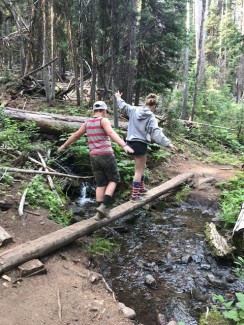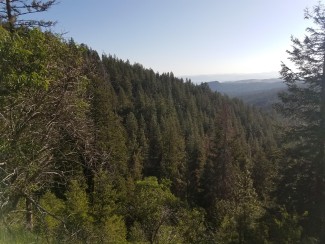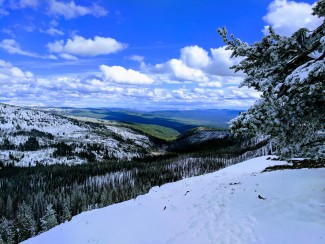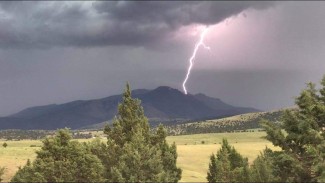Safety and Outdoor Ethics
- Before starting out, do warm-up exercises. Stretching gradually increases heart rate, temperature and circulation to your muscles. Also, after a night's rest, your muscles need warming. Stretching gets the body going and increases your flexibility.
- Start out slowly, gradually increasing your pace and distance traveled.
- Let the slowest person in your hiking, paddling, and biking or cross-country skiing party set the pace. This is especially important when children are a apart of your group.
- Plan the trip ahead of time and assign tasks that people enjoy. If someone doesn't cook, don't force him or her to do it. The goal is to have a good time outdoors.
- Take turns leading the group and sharing decision-making responsibilities.
- Hike, bike, or ski only on marked trails in wilderness areas unless bushwhacking is allowed and you have excellent navigation skills.
- Hike and travel in groups as much as possible, especially during winter and in hazardous terrain.
- Leave your itinerary with a friend or family member and check in with them upon your return.
- Learn basic repair skills for changing a bike tire, fixing a backpack or mending a snowshoe. Remember to take repair kits on your trail.
- Mountain weather is generally cooler, cloudier, and windier than in lowland areas. For every 1,000 feet of elevation, the temperature often drops three to five degrees. Thus, it's best to dress in layers. Polyester clothing worn closest to your skin will trap warm air next to the skin and transfer or wick body moisture away.
- Wear sunglasses and a hat or visor when you hike, ski or paddle. Snow blindness, caused by the sun's glare on snow, can also be caused by sunlight reflecting off water and boulders. Keep your eyes and face covered especially during your first few days outdoors.
- Bring sunscreen no matter the season. You can get painful sunburn even in subfreezing temperatures.
- Bring a customized first aid kit tailored to your outing.
- Develop an emergency plan before you start your trip. Make sure everyone knows what to do if they become lost or a medical emergency arises. Give children whistles with the instructions to "stop and blow" if they become lost.
- Take frequent rests or vary your pace to recover from strenuous activity spurts. A steady pace will get you there with less discomfort than the sprint-and-catch-your-breath approach.
- Drink plenty of water. Water is heavy to carry, but thirst on the trail is a hazard. Take a tip from athletes: before a hike, drink some water so you're well hydrated and energized. Never drink your total supply between refills.
- Backcountry water supplies are unpredictable. It's better to arrive at a gushing stream with 1/3 quart of water left, than to arrive at an empty stream and have no water left at all. Treat or filter all water.
- Pack carbohydrate-energy bars, granola, candy, or fruit. They provide an instant pick-me-up on the trail.
- Give yourself about two hour's daylight to set up camp.
- Many national parks and forests and many state parks prohibit dogs. Be sure to keep pets on leashes in restricted areas, especially in cattle and sheep country. Bring water for pets and make sure they have nametags. Watch for injuries to your dog's footpads in rocky areas, on ice or in extremely hot terrain.
- Pay attention to local regulations, particularly concerning campfires. In many desert or drought areas, fires are prohibited and you must use a camp stove.

Whether you're roughing it in a tent or planning a family outing to a national forest, there are many ways to make sure your experience is fun and safe. Consider the following safety tips:
- Pack a first aid kit. Your kit can prove invaluable if you or a member of your group suffers a cut, bee sting or allergic reaction. Pack antiseptics for cuts and scrapes, tweezers, insect repellent, bug spray, a snake bite kit, pain relievers, and sunscreen.
- Bring emergency supplies. In addition to a first aid kit, this includes: a map, compass, flashlight, knife, waterproof fire starter, personal shelter, whistle, warm clothing, high energy food, water, and insect protection.
- Learn the ABC's of treating emergencies. Recognizing serious injuries will enable you to attend to a victim until medical help arrives.
- Before you leave, find out the weather report. When you arrive at the site, watch the skies for changes and carry a compact weather radio. In inclement weather, find shelter until the worse passes. Stay dry - wet clothes contribute to heat loss. Also, keep sleeping bags and important gear, dry at all times.
- Arrive early. Plan your trip so that you arrive at your actual campsite with enough daylight to check over the entire site and to set-up camp.
- Check for potential hazards. Be sure to check the site thoroughly for glass, sharp objects, branches, large ant beds, poison ivy, bees, and hazardous terrain.
- Avoid areas of natural hazards. Check the contour of the land and look for potential trouble due to rain. Areas that could flood or become extremely muddy can pose a problem.
- Inspect the site. Look for a level site with enough room to spread out all your gear. Also, a site that has trees or shrubs on the side of prevailing winds will help block strong, unexpected gusts.
- Build fires in a safe area. Your open fires and fuel-burning appliances must be far enough away from the tent to prevent ignition from sparks, flames, and heat. Never use a flame or any other heating device inside a tent. Use a flashlight or battery-powered light instead.
- Make sure your fires are always attended. Be sure you have an area for a fire that cannot spread laterally or vertically - a grill or stone surface is ideal. When putting the fire out, drown it with water, making sure all embers, coals and sticks are wet. Embers buried deep within the pile have a tendency to reignite later.
- Pitch your tent in a safe spot. Make sure your tent is made of a flame-retardant fabric, and set up far enough away from the campfire. Keep insects out of your tent by closing the entrance quickly when entering or leaving.
- Dispose of trash properly. Remember to recycle - use the proper recycling bins if available.
- Be cautious when using a propane stove. Read the instructions that come with the stove and propane cylinder. Use the stove as a cooking appliance only - never leave it unattended while it's burning.
- Watch out for bugs. Hornets, bees, wasps, and yellow jackets are a problem at many campsites. Avoid attracting stinging insects by wearing light-colored clothing and avoiding perfumes or colognes. Should such an insect approach, do not wave wildly and swat blindly - instead use a gentle pushing or brushing motion to deter them.
- Beware when encountering wildlife. To ward off bears, keep your campsite clean, and do not leave food, garbage, coolers, cooking equipment or utensils out in the open. Remember that bears are potentially dangerous and unpredictable - never feed or approach a bear. Use a flashlight at night - many animals feed at night and the use of a flashlight may warn them away.
- Beware of poisonous plants. Familiarize yourself with any dangerous plants that are common to the area. If you come into contact with a poisonous plant, immediately rinse the affected area with water and apply a soothing lotion such as calamine to the affected area.
- Practice good hygiene. Make sure you wash your hands, particularly after using the toilet and before handling food, to prevent everyone in your group becoming ill.

- Pay close attention to your surroundings and landmarks, and relate this to your location on a map.
- Stay calm if you get lost, panic is your greatest enemy. Try to remember how you got to your present location.
- Trust your map and compass, and do not walk aimlessly. If you are on a trail, don't leave it.
- Stay put if it is nightfall, if you are injured, or if you are near exhaustion.
- As a last resort, follow a drainage or stream downhill. This can be hard going but will often lead to a trail or road.

Leave No Trace is a system of outdoor ethics that serves as a list of guidelines to help us take care of nature. There are seven principles that when followed, enhances everyone’s enjoyment of places like our forest.
Leave No Trace Principles
- Plan Ahead and Prepare
Know where you’re going! Maps are available online for free, and for purchase at our office locations. Have enough food, water, and supplies like warm clothing for your travels. Always tell someone where you are going and when you will return. - Travel and Camp on Durable Surfaces
Camp away from springs and riparian areas like streams, which are especially valuable and sensitive. Many plants are easily trampled, and wildlife rely on these areas. Other fragile areas are subalpine meadows and wildflower fields. Durable surfaces are places like rock outcroppings, bare dirt patches, and beds of pine needles. - Dispose of Waste Properly
Pack out all trash and bury human waste at least 6 inches deep. Malheur National Forest campgrounds do not have trash services. - Leave What You Find
Archeological sites are precious and protected. The Malheur National Forest has thousands of years of history. These old places are sometimes the only way we can know what people’s lives were like in the past. Natural features are precious too; so please do not deface natural features or harvest materials without the proper permits. - Minimize Campfire Impacts
Know current fire regulations. Public Use Restrictions (PUR) can be found here or by calling 541-575-3113. Put out your fire completely before leaving your site. Some areas of the forest may be closed to personal fires during specific Public Use Restrictions. Find out more here. - Respect Wildlife
Do not feed wildlife, or leave trash or food out for animals to get. Human food isn’t good for them, and can either make them dependent or harmful to people. Give animals space if you spot them. Safe distances are about 75 feet from deer and elk, and 300 feet from bears, wolves, and cougars. - Be Considerate of Other Visitors
The forest belongs to everyone! Keep loud noises to a minimum, especially in high use areas like campgrounds or picnics spots. Many of our camping areas have posted quiet hours, so be respectful of things like generators, music, and big gatherings.
- Learn as much as you can about the area you plan to visit
- Carry a map and know your travel routes.
- Contact the nearest Ranger District office for current conditions.
- Check the weather conditions before you leave and be observant of changing weather conditions.
- In addition to the 10 essentials be sure to be prepared for adverse weather by having raingear and proper footwear that provides ankle support.

High on the list of activities where people are injured by lightning are mountain hiking, climbing, camping, fishing, boating, and golfing.
Many vacationers are unaware of the measures they can take to lower their risk of being struck. They should educate themselves about lightning strikes. They should be near safe shelter and try to avoid high terrain, golf courses, and bodies of water during high lightning activity (late morning to evening).
- If you are caught above the tree line when a storm approaches, descend quickly. Avoid isolated trees. It is better to run into a forest.
- Electric storms can also develop in the middle of the night. To lower your odds, don't pitch your tent near the tallest trees in the vicinity.
- Hikers, golfers, and others should run into a forest if a shelter or car is not nearby.
- Drop metal objects like golf clubs, tennis rackets, umbrellas, and packs with internal or external metal frames.
- Get off bicycles, motorcycles, horses, and golf carts. Metal bleachers at sports events, metal fences, and utility poles are also to be avoided.
- If you are caught in an open field, seek a low spot. Crouch with your feet together and head low.
- If Someone Is Struck - People who have been hit by lightning carry no electric charge and can be safely tended to. Also, victims who appear dead can often be revived. If the person is not breathing, begin mouth-to-mouth resuscitation. But if a pulse is absent as well and you know cardiopulmonary resuscitation (CPR), begin CPR. Stay with the victim until help arrives.
- Don't sit or lie down, because these positions provide much more contact with the ground, providing a wider path for lightning to follow. If you are with a group and the threat of lightning is high, spread out at least 15 feet apart to minimize the chance of everybody getting hit (see "If Someone Is Struck").
- Don't return to an open area too soon. People have been struck by lightning near the end of a storm, which is still a dangerous time.
- Swimmers, anglers, and boaters should get off lakes or rivers and seek shelter when storms approach. Drop any fishing rods. Boaters who cannot get off the water before the storm hits should crouch low. Once on land, get at least 100 yards away from shore.
- Remember: This information is not intended as a substitute for medical treatment. If you have a health-related concern, consult a physician. Also, the tips discussed here may lower injury risk, but the unpredictability of lightning affords no guarantees.




